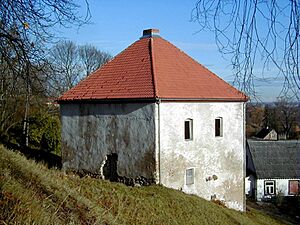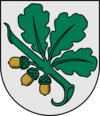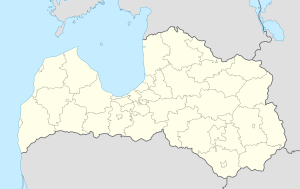Kandava facts for kids
Quick facts for kids
Kandava
|
|||
|---|---|---|---|
|
Town
|
|||

Street in Kandava
|
|||
|
|||
| Country | |||
| District | Tukums Municipality | ||
| Town rights | 1917 | ||
| Area | |||
| • Total | Lua error in Module:Wd at line 1,575: attempt to index field 'wikibase' (a nil value). km2 (Formatting error: invalid input when rounding sq mi) | ||
| • Land | Lua error in Module:Wd at line 1,575: attempt to index field 'wikibase' (a nil value). km2 (Formatting error: invalid input when rounding sq mi) | ||
| • Water | Expression error: Unexpected < operator. km2 (Formatting error: invalid input when rounding sq mi) | ||
| Population | |||
| • Total | Lua error in Module:Wd at line 1,575: attempt to index field 'wikibase' (a nil value). | ||
| Time zone | UTC+2 (EET) | ||
| • Summer (DST) | UTC+3 (EEST) | ||
| Postal code |
LV-3120
|
||
| Calling code | +371 631 | ||
| Number of city council members | 11 | ||
| Website | http://www.kandava.lv/ | ||

Kandava is a town in Tukums Municipality in Latvia. It is located in the Courland region of the country. As of January 2020, about 3,656 people lived in Kandava.
Contents
History of Kandava
Early Times and Crusades
Long ago, the area where Kandava is now was home to Finnic tribes. By the 10th century, a group called the Curonians moved into the area. A place called Kandava hillfort became an important center for the Curonians. A hillfort is a settlement built on a hill for protection.
Kandava was first mentioned in a peace treaty in 1230. This treaty was between the Livonian Brothers of the Sword (a group of knights) and the local Curonian people. The Curonians were allowed to keep their land. But they had to become Christians and pay a yearly tax. They also had to help the knights in their fights against other groups.
However, after some local uprisings, a new treaty was signed in 1253. The land around Kandava then became part of the Livonian Order. This was a powerful group of knights.
The Livonian Confederation Period
Around 1257, a military castle was built in Kandava. Over time, this castle was taken apart. Today, you can only see its foundations in a town park. The oldest building still standing is a guard tower built in 1334. This tower was later used to store gunpowder.
By 1312, Kandava castle became the home of a vogt, who was like a local governor. It also became the main administrative center for the area. In the 16th century, Kandava had churches, schools, and taverns.
The Duchy of Courland and Semigallia
During the time of the Duchy of Courland and Semigallia, Kandava became an important administrative center. It was given village rights in 1625.
Under the rule of Duke Jacob Kettler, several factories were built near Kandava. There was a factory that wove flax into cloth. There was also a gunpowder factory that used local materials like brimstone and saltpeter. At this time, Kandava's population grew to about 1,000 people.
However, the town's growth stopped because of wars. The Second Northern War brought Swedish armies, who attacked and destroyed Kandava Castle. Later, during the Great Northern War, the Swedes destroyed the castle again in 1703. In 1710, a terrible plague spread through the town. Out of 600 residents, only a few craftsmen survived.
By the 18th century, Kandava castle was no longer important for military defense. In the 1730s, two schools opened in the village. A new church was also built in 1736.
Under Russian Rule and Modern Times
In 1795, the Duchy of Courland and Semigallia became part of the Russian Empire. At that time, only 439 people lived in Kandava. In 1799, Jewish people were allowed to settle in the village.
In 1812, Napoleon's army briefly occupied Kandava. During the 19th century, Kandava grew quickly. By 1892, about 2,100 people lived there. Because of this growth, Kandava gained some town rights. Its first town council was elected in 1893.
In 1904, a railway line was built near the town, connecting Riga and Ventspils. During the revolution of 1905, local workers took control of Kandava for a month.
By 1914, Kandava had 2,300 residents. It also had a town school, a water mill, a power station, and several sawmills. When the First World War started, many people fled from the German army. However, during the German occupation, Kandava was given full town rights in 1917.
After the Latvian War of Independence, Kandava was occupied by different armies. In 1920, the population was 1,045. In the 1920s and 1930s, Kandava had a post office, a telephone exchange, a court, and two primary schools.
After the Second World War, Kandava became part of the Latvian SSR. An agricultural technical school opened in 1945. In 1963, a branch of the Riga Radio factory was built in the town. Today, Kandava has several businesses that work with wood.
A famous botanist, Theophil Joachim Heinrich Bienert, who studied plants, was born in Kandava.
Twin Towns and Sister Cities
 A twin town, or sister city, is a partnership between two towns in different countries. They often share cultural or historical ties. Kandava is part of a special group called the Charter of European Rural Communities. This group connects rural towns across the European Union.
A twin town, or sister city, is a partnership between two towns in different countries. They often share cultural or historical ties. Kandava is part of a special group called the Charter of European Rural Communities. This group connects rural towns across the European Union.
Charter of European Rural Communities
 Bienvenida, Spain
Bienvenida, Spain Bièvre, Belgium
Bièvre, Belgium Bucine, Italy
Bucine, Italy Cashel, Ireland
Cashel, Ireland Cissé, France
Cissé, France Desborough, England, United Kingdom
Desborough, England, United Kingdom Esch, Netherlands
Esch, Netherlands Hepstedt, Germany
Hepstedt, Germany Ibănești, Romania
Ibănești, Romania Kannus, Finland
Kannus, Finland Kolindros, Greece
Kolindros, Greece Lassee, Austria
Lassee, Austria Medzev, Slovakia
Medzev, Slovakia Moravče, Slovenia
Moravče, Slovenia Næstved, Denmark
Næstved, Denmark Nagycenk, Hungary
Nagycenk, Hungary Nadur, Malta
Nadur, Malta Ockelbo, Sweden
Ockelbo, Sweden Pano Lefkara, Cyprus
Pano Lefkara, Cyprus Põlva, Estonia
Põlva, Estonia Samuel, Portugal
Samuel, Portugal Slivo Pole, Bulgaria
Slivo Pole, Bulgaria Starý Poddvorov, Czech Republic
Starý Poddvorov, Czech Republic Strzyżów, Poland
Strzyżów, Poland Tisno, Croatia
Tisno, Croatia Troisvierges, Luxembourg
Troisvierges, Luxembourg Žagarė, Lithuania
Žagarė, Lithuania
- Other twin towns
Gallery
See also
 In Spanish: Kandava para niños
In Spanish: Kandava para niños






